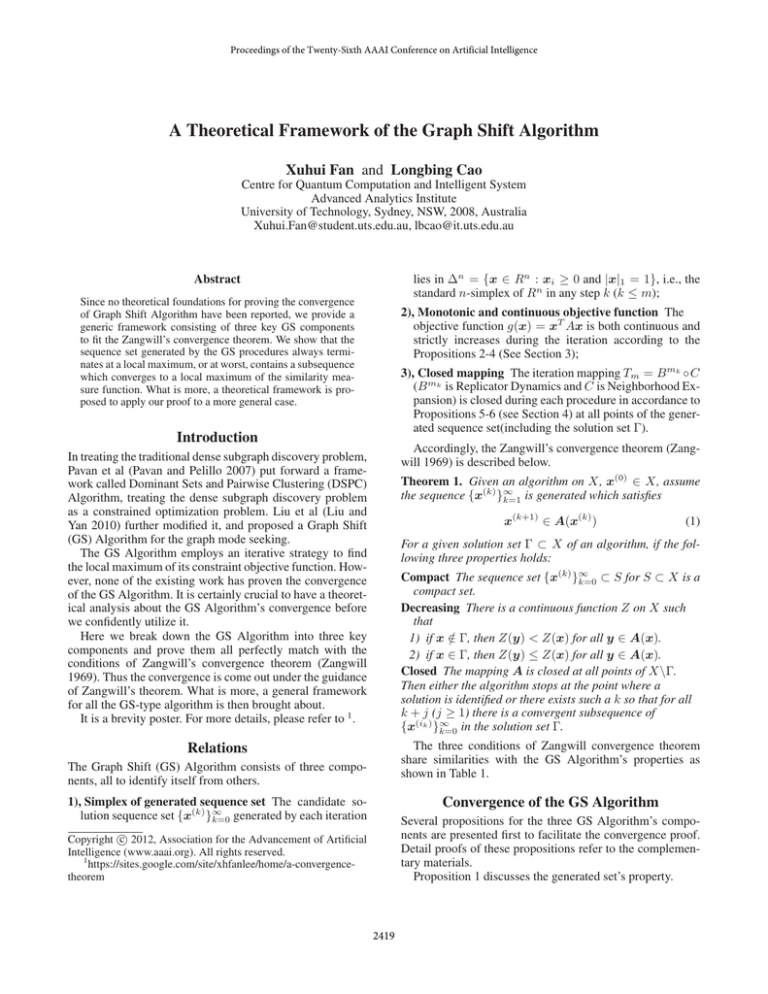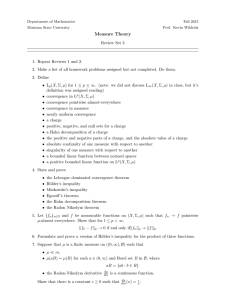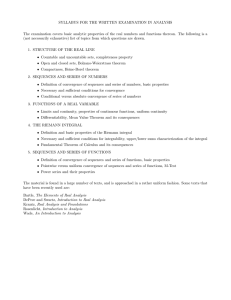
Proceedings of the Twenty-Sixth AAAI Conference on Artificial Intelligence
A Theoretical Framework of the Graph Shift Algorithm
Xuhui Fan and Longbing Cao
Centre for Quantum Computation and Intelligent System
Advanced Analytics Institute
University of Technology, Sydney, NSW, 2008, Australia
Xuhui.Fan@student.uts.edu.au, lbcao@it.uts.edu.au
lies in ∆n = {x ∈ Rn : xi ≥ 0 and |x|1 = 1}, i.e., the
standard n-simplex of Rn in any step k (k ≤ m);
Abstract
Since no theoretical foundations for proving the convergence
of Graph Shift Algorithm have been reported, we provide a
generic framework consisting of three key GS components
to fit the Zangwill’s convergence theorem. We show that the
sequence set generated by the GS procedures always terminates at a local maximum, or at worst, contains a subsequence
which converges to a local maximum of the similarity measure function. What is more, a theoretical framework is proposed to apply our proof to a more general case.
2), Monotonic and continuous objective function The
objective function g(x) = xT Ax is both continuous and
strictly increases during the iteration according to the
Propositions 2-4 (See Section 3);
3), Closed mapping The iteration mapping Tm = B mk ◦C
(B mk is Replicator Dynamics and C is Neighborhood Expansion) is closed during each procedure in accordance to
Propositions 5-6 (see Section 4) at all points of the generated sequence set(including the solution set Γ).
Introduction
Accordingly, the Zangwill’s convergence theorem (Zangwill 1969) is described below.
In treating the traditional dense subgraph discovery problem,
Pavan et al (Pavan and Pelillo 2007) put forward a framework called Dominant Sets and Pairwise Clustering (DSPC)
Algorithm, treating the dense subgraph discovery problem
as a constrained optimization problem. Liu et al (Liu and
Yan 2010) further modified it, and proposed a Graph Shift
(GS) Algorithm for the graph mode seeking.
The GS Algorithm employs an iterative strategy to find
the local maximum of its constraint objective function. However, none of the existing work has proven the convergence
of the GS Algorithm. It is certainly crucial to have a theoretical analysis about the GS Algorithm’s convergence before
we confidently utilize it.
Here we break down the GS Algorithm into three key
components and prove them all perfectly match with the
conditions of Zangwill’s convergence theorem (Zangwill
1969). Thus the convergence is come out under the guidance
of Zangwill’s theorem. What is more, a general framework
for all the GS-type algorithm is then brought about.
It is a brevity poster. For more details, please refer to 1 .
Theorem 1. Given an algorithm on X, x(0) ∈ X, assume
the sequence {x(k) }∞
k=1 is generated which satisfies
x(k+1) ∈ A(x(k) )
(1)
For a given solution set Γ ⊂ X of an algorithm, if the following three properties holds:
Compact The sequence set {x(k) }∞
k=0 ⊂ S for S ⊂ X is a
compact set.
Decreasing There is a continuous function Z on X such
that
1) if x ∈
/ Γ, then Z(y) < Z(x) for all y ∈ A(x).
2) if x ∈ Γ, then Z(y) ≤ Z(x) for all y ∈ A(x).
Closed The mapping A is closed at all points of X\Γ.
Then either the algorithm stops at the point where a
solution is identified or there exists such a k so that for all
k + j (j ≥ 1) there is a convergent subsequence of
{x(ik ) }∞
k=0 in the solution set Γ.
The three conditions of Zangwill convergence theorem
share similarities with the GS Algorithm’s properties as
shown in Table 1.
Relations
The Graph Shift (GS) Algorithm consists of three components, all to identify itself from others.
Convergence of the GS Algorithm
1), Simplex of generated sequence set The candidate solution sequence set {x(k) }∞
k=0 generated by each iteration
Several propositions for the three GS Algorithm’s components are presented first to facilitate the convergence proof.
Detail proofs of these propositions refer to the complementary materials.
Proposition 1 discusses the generated set’s property.
c 2012, Association for the Advancement of Artificial
Copyright Intelligence (www.aaai.org). All rights reserved.
1
https://sites.google.com/site/xhfanlee/home/a-convergencetheorem
2419
GS Algorithm
Simplex
M onotonic
Closed
The proof of Theorem 2 provides us a guideline on GStype algorithms’ proving. (1) Breaking down the GS-type
algorithm into three parts: generated set, objective function and mapping. (2) Check if these three parts all satisfy
the corresponding requirements. Any part unsatisfied is regarded as unsuitable for applying this framework, otherwise
it is convergent under our framework.
Figure 1 shows the framework to prove the convergence
of GS-type algorithms step by step.
Zangwill’s theorem
∼
∼
∼
Compact
Decreasing
Closed
Table 1: GS Algorithm and Zangwill’s Theorem’s similarities
Proposition 1. The sequence set {x(k) }∞
k=0 ⊂ S generated
by the mapping Tm = B mk ◦ C is a compact set.
Propositions 2-4 discuss the monotonicity of g(x) under
the mapping Tm = B mk ◦ C.
Proposition 2. The objective function f (x) = xT Ax
strictly increases along the Replicator Dynamics (B mk )
when x ∈ X/Γ.
Proposition 3. The objective function f (x) = xT Ax
strictly increases along the neighborhood expansion (C) operation.
Proposition 4. g(x) = xT Ax is a function both continuous
and strictly increasing during the mapping Tm = B mk ◦ C
when x ∈ X/Γ, but just increasing if x ∈ Γ.
Propositions 5-6 validate the closed property of the GS
Algorithm’s mapping Tm .
Lemma 1. Given two continuous functions: f : I → J(⊂
r), g : J → R, the composition g ◦ f : I → R, x 7→
g(f (x)) is continuous.
Proposition 5. The mapping C is closed on all points of
X\Γ.
Proposition 6. The mapping Tm = B mk ◦ C is closed on
X/Γ.
With the above preparations, we have the following Theorem 2.
Theorem 2. Let A = (aij )(n×n) be a similarity matrix
with diagonal values 0, Tm be the GS Algorithm’s mapping, Γ be the solution set, and x(0) be an arbitrary initial starting point, then either the iteration sequence {x(r) }
(r = 1, 2, . . .) terminates at a point x∗ in the solution set Γ
or there is a subsequence converging to a point in Γ.
Figure 1: Proving framework for GS-type algorithm convergence
Based on the proposed framework, we can prove that
other GS-type algorithms such as the DSPC Algorithm (Pavan and Pelillo 2007) are applicable for the above process
and they are convergent.
Conclusions and Future work
We propose a generic theoretical framework to prove the
convergence of the Graph Shift (GS) Algorithm. The GS Algorithm’s extracted three key components are mapped to the
Zangwill convergence theorem’s three key conditions. Consequently, the convergence of the GS Algorithm is proved by
applying the Zangwill convergence theorem. Also, we extend our work to the GS-type algorithm and build up a solid
theoretical framework to this general GS-type algorithms.
In the future, Banach’s contraction theory and optimization methods on nonconvex mathematical program are being considered in our problem so as to suit in a more general
case.
Proof. Taking ĝ(x) = −g(x) = −xT Ax as the continuous
function Z and Tm as the algorithm mapping A in Theorem
1. Proposition 1 shows that the sequence set {x(k) }∞
k=1 generated by Tm is a compact set. ĝ(x) is continuous and strict
decreasing as the continuity and strict increasing characteristic of g(x) in the trajectory of Tm are proven by Proposition
4. Proposition 6 asserts Tm is closed on x/Γ (Γ is the solution set). According to the Zangwill’s convergence theory,
Theorem 2 holds as all three properties are satisfied.
Acknowledgement
This work is sponsored in part by ARC Discovery Grants
(DP1096218) and ARC Linkage Grant (LP100200774).
References
Liu, H., and Yan, S. 2010. Robust graph mode seeking by
graph shift. In International Conference on Machine Learning.
Pavan, M., and Pelillo, M. 2007. Dominant sets and pairwise
clustering. Pattern Analysis and Machine Intelligence, IEEE
Transactions on 29(1):167–172.
Zangwill, W. 1969. Nonlinear programming: a unified approach. Prentice-Hall international series in management.
Prentice-Hall.
GS-type Algorithm convergence framework
Here, we further propose a framework for the convergence
proof of GS-type algorithms.
Def. 1. An algorithm is a GS-type algorithm if and only if it
satisfies the conditions on three key components: simplex of
generated sequence set, monotonic and continuous objective
function and closed mapping.
2420







